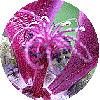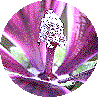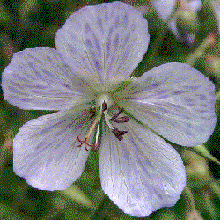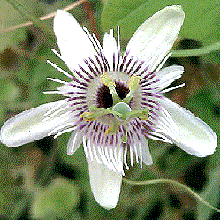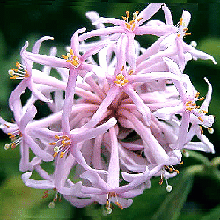Seeds are the result of fertilisation of the ovules by pollen. The ovules are 'half a seed' - they contain the DNA of the female parent plant (sometimes called 'the seed parent'), but cannot develop into complete seeds until they have had the DNA of the male parent plant (sometimes called 'the pollen parent') added.
The DNA is contained on chromosomes, and when the ovules or stamens are being made, the plant's DNA divides in half, and each parent puts a set of its own chromosomes into its half of the seed (the ovules for the female parent, and the pollen for the male parent). When the ovules are fertilised, the two sets of chromosomes join together to make the double set which a new plant needs. The fact that the same genes are passed on to each succeeding generation is what makes the new plant similar to its parents, so daisies produce daisies in the next generation, and do not have the DNA to make a tree, for instance.
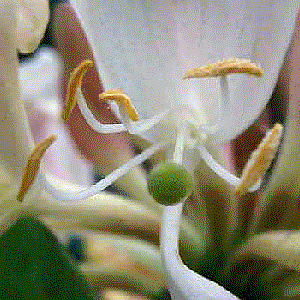 |
For fertilisation to take place, pollen of the right type must join up with the ovules. The pollen is contained in bags called pollen sacs which open when the pollen is ripe. Some pollen is only ripe for a few days, some lasts much longer. We think of pollen as yellow powder, but it can be white, orange, brown, purple or black, and it comes in many different shapes and sizes. Botanists are able to identify a plant by the shape of the individual pollen grains!
In most plants, each flower contains both an ovary and stamens. The plant contains both male and female parts. This is the centre of an individual flower on a Honeysuckle. There are five yellow stamens, and a round green stigma leading to an inferior ovary which will develop into a berry. The ovary can be either inside the flower (called superior) or behind the flower (called inferior), and can contain just one or many ovules. |
Sometimes, the stamens are on one flower, and the ovules are in another flower. Sometimes, a plant produces only male flowers, that is, flowers which have only stamens, so they will not produce seeds - the Holly is an example. The female flowers, those with a stigma leading to ovules, are on a separate plant. In the Holly, a separate male plant is needed to pollinate the flowers so the female plant can produce berries. Plants with both male and female parts in the same flower, or with male and female flowers on the same plant, are called 'monoecious'. Plants that have either all male or all female flowers are called 'dioecious'. These flowers are Malva sylvestris - the one on the right is the male flower - you can see the white stamens clustered together. The flower on the left is the female flower - it has a very divided, curly purple stigma. Here they are in close-up: |
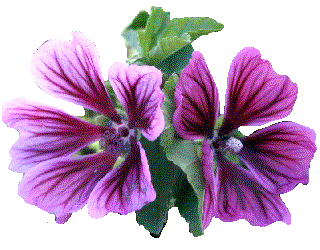
|
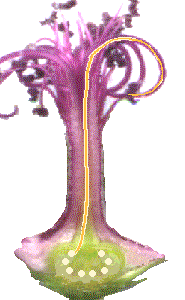 |
When pollen with the right chemical password lands on the stigma, it grows down the style to reach the ovules. In the picture, the yellow tube shows the journey the pollen grain has to make to reach the ovary. The ovules are shown as pale yellow circles - the real ovules are too small to be seen at this stage. The ovules can then grow on to produce the seeds. The stigma is only able to receive the pollen for a limited time. When it is ready, the tip is sticky to help the pollen grains stay in place. Stigmas also come in many shapes, sizes and colours. The stigma is on the end of a stalk called the style. Sometimes the style is long and thin, and the stigma on top can be rounded like a pin. In Primroses, if you can see the round stigma in the throat of the flower, it is called 'pin-eyed'. When the short stamens are visible in the throat, it is called 'thrum-eyed'. Sometimes, the style and stigma are short and fat, as in a Poppy, or the stigma may be divided. The style and stigma can be green, or pink, or orange - in some cases, they match the colour of the flower. |
| The pollen gets on to the stigma in many ways. Sometimes, it is blown from the stamens of one flower or one plant onto the stamens of another flower. Sometimes, the pollen is carried from flower to flower by insects. To attract pollinating insects, many flowers produce sweet nectar. These flowers often have long tubes, and the insects that pollinate them need long tongues. Larger flowers of this type are sometimes pollinated by humming birds, which also have long tongues. Some flowers are pollinated by moths, and these often have pale colours or perfumes which are stronger at night.
Pollinating insects get dusted with pollen as they brush against the stamens while trying to collect the nectar, and when they visit another flower to drink more nectar, the pollen is deposited on the stigma of the new flower. A flower that is pollinated by the pollen of another flower is cross-pollinated. When the pollen comes from the same flower, the flower is self-pollinated. | 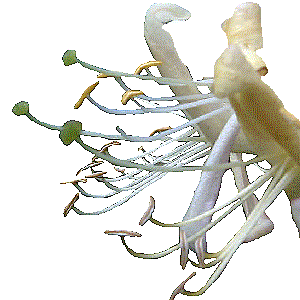 |
| Each seed is unique, formed from one ovule and one grain of pollen, with its own particular combination of all the separate genes from each of its parents. Because of this diversity and the possibilities it gives the next generations, nature sometimes takes precautions to prevent flowers being pollinated by their own pollen. Sometimes, the stigma won't accept pollen from the same flower or the same plant, sometimes the pollen ripens at a different time from the stigmas, or the stigmas are placed above the stamens so that it is more difficult for the flowers to be self-pollinated.
On the other hand, some plants have their stigmas and stamens close together, so that self-pollination is easier, and some plants can produce seeds without the flowers opening at all. These are called cleistogamous seeds. |
|
